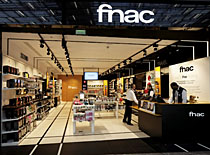What is FNAC? One of the largest record stores in Paris. Now it has locations in Spain and Brazil. But the ones I’m most familiar with are the locations at Wagram and Les Halles, Paris.
When I grew up in the US in the 70s, there was no Tower Records, no Virgin Records, no Target or Wal-Mart. You could get music at K-Mart or Sears, but most likely you bought it at a small record store in a mall (Sam Goody or Kemp Mill Records). The first two records we bought were Sha Na Na (me) and KISS Hotter Than Hell (my brother) at a small shop in Gaithersburg. This was back when the stores stocked vinyl, cassettes, and 8-tracks. But as a kid I wasn’t buying records, I couldn’t drive around, and my musical tastes were obviously immature: Sha Na Na and the Beach Boys, that was it.
Then we moved to Paris, France in January 1979. I started growing up, becoming a teenager, and developing a taste for music and an insatiable desire for it – which continues to this day. I quickly found out where the record stores were and how they were set up.
Paris has a few small shops, but they had poor selections and high prices. They obviously couldn’t compete with FNAC, the huge chain. I was most familiar with the branch on Ave. Wagram, just a few blocks from the Etoile, but I’d also been to the Les Halles store a few times (where I bought The White Album on CD) and the Montparnasse store once. That one was out of the way on the Left Bank, whereas the Wagram store was pretty much in my backyard. In fact, it was on my way home from school where the late bus dropped us off.
I’d keep my lunch down to a Coke and fries at the school cafeteria (maybe a Raider – aka Twix – bar for dessert) and save the rest of the money to buy records.
FNAC also sold concert tickets. They posted the shows on a whiteboard in marker, and the tickets were all general admission. They tore the tickets off a booklet, and rather than the plain generic blue/white ticket you get from Ticketmaster, these were in full color with the album cover.
FNAC did have some realistic competition. A store called Nuggets, off George V, was fairly large. The window display showed Iron Maiden and Killers, the first time I’d been exposed to that band. But my shopping at this store was primary focused on getting as many AC/DC albums as I could: High Voltage, Dirty Deeds Done Dirt Cheap, Let There Be Rock, and Powerage (we got Highway to Hell and Back in Black for Christmas, and found If You Want Blood (You Got It) at the PX in Germany). For Those About To Rock hadn’t come out yet.
Another competitor was Bazar Hotel de Ville (BHV, pronounced “Bay Osh Vay”), a large department store next to... the Hotel de Ville (east side of Right Bank) with a huge record department. I got my first Deep Purple album, Deepest Purple, on vinyl there. I knew I wanted “Smoke on the Water” but also wanted as many other songs as possible, which is why I didn’t get Machine Head to start off with.
Much later, about the time I was in college and coming back on semester break, Virgin Records opened a store on the Champs Elysees. The store was about as large as FNAC and equally stocked and priced. They were close enough together (within walking distance). When I’d wake up from jet lag on returning to Paris, the first place I’d walk to was here. I’d even browse through and come up with a “shopping” list to compare notes with my friend Ken about which import versions to get.
A fourth, and unlikely, competitor, was Uncle Sam. The Army-Air Force Exchange Service (AAFES) runs the Post Exchanges (PXs) at various US military bases. We went to the base at SHAPE, Belgium, as it was closest to Paris. Normally you don’t expect a PX to have anything close to a decent selection, but somehow, every now and then, you’d find something really special. I got Sad Wings of Destiny and Sin After Sin (Judas Priest) there – and got Master of Reality (Black Sabbath) on tape at the PX at Henderson Hall, a Marine base next to Arlington Cemetary.
RIP Tower Records. While I’m on the topic, I should give this issue a mention. As a fan of a wide variety of obscure music – which you WON’T find at Sam Goody, FYE, or Best Buy – I was particularly addicted to Tower Records. Bar none, the top place to find Hawkwind CDs, at least before Amazon.com rolled around. Whoever did the buying at the Tyson’s store was a trooper. I snagged the first Hawkwind CD (self-titled) and Space Ritual there, among many other fantastic finds. In fact, it was so good I barely missed buying records overseas.
Online buying. Amazon.com of course, but also Allthatsheavy.com (the Stoner Rock store), and the King Crimson website is a great source for their own music. I still go to Best Buy and Borders occasionally, but for every CD I buy in the store, I probably buy 3-4 online.
But for me it all started with FNAC in Paris. It was living there that I got into AC/DC, heavy metal, and also started learning to play guitar. FNAC was very much an important part of my life growing up in Paris.
P.S. 2019. Fall of 2017 I went back to Paris for the first time since leaving there in August 1990. You can bet I went to FNAC again - though the locations are slightly different. Ample supply of CDs AND vinyl. (Homer drooling)...


